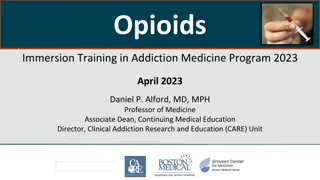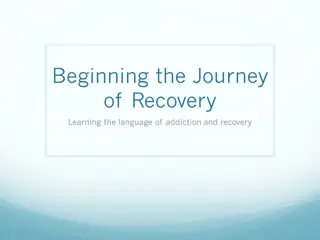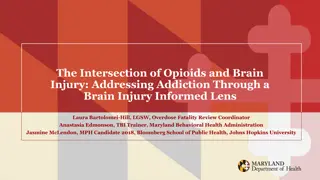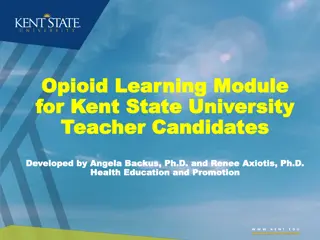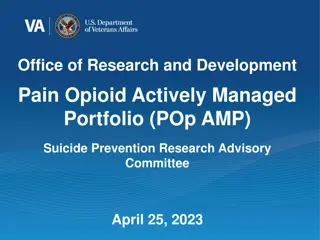The Opioid Crisis: A Timeline of Addiction and Recovery Efforts
The opioid crisis traces back to the invention of heroin in 1874 and the subsequent increase in opioid prescriptions in the mid-1990s. Reassurances from pharmaceutical companies led to a surge in opioid use for non-cancer pain, contributing to addiction and overdoses. Efforts to combat the crisis include the work of professionals like Claudia Peters Ragni at The Kenneth Peters Center for Recovery, highlighting the need for effective recovery programs amidst the ongoing challenges.
Download Presentation

Please find below an Image/Link to download the presentation.
The content on the website is provided AS IS for your information and personal use only. It may not be sold, licensed, or shared on other websites without obtaining consent from the author.If you encounter any issues during the download, it is possible that the publisher has removed the file from their server.
You are allowed to download the files provided on this website for personal or commercial use, subject to the condition that they are used lawfully. All files are the property of their respective owners.
The content on the website is provided AS IS for your information and personal use only. It may not be sold, licensed, or shared on other websites without obtaining consent from the author.
E N D
Presentation Transcript
Claudia Peters Ragni Founder/Director The Kenneth Peters Center for Recovery
Heroin was invented when a scientist was mixing and simmering morphine with acetic anhydride to find a cure for opium addiction. The year was 1874, the place was St Mary s hospital in London. By late 1800 s, Bayer Pharma picked it up and promoted heroin as a cure all for everything from asthma to bronchitis, the common cold and teething babies. When it became clear that heroin was as addicting as opium, morphine and other drugs of abuse, it was no longer considered a medication with any medical value.
Prior to 1995, doctors did not routinely prescribe opiates other than for palliative care due to the addictive nature of the medication. Non-narcotic alternatives were routinely recommended such as chiropractic, NSAID s, etc. The increase in opioid prescriptions in the mid-1990 s was influenced by reassurances given to prescribers by pharmaceutical companies and medical societies claiming that the risk of addiction to prescription opioids was very low. During this time, pharmaceutical companies also began to promote the use of opioids in patients with non-cancer related pain even though there was a lack of data regarding the risks and benefits in these patients. By 1999, 86% of patients using opioids were using them for non cancer pain
WAVE ONE In the late 1990s, pharmaceutical companies reassured the medical community that their opioid pain relievers would not put patients at risk of addiction. Because of this, health care providers began writing prescriptions at greater rates for the treatment of non-cancer-related pain. However, these prescription opioids were highly addictive. As they became more easily and widely available, the opioid crisis was born.
(Oct 31, 2000, President Clinton signed HR3244 Decade of Pain Control and Research declaring we will eliminate pain by 2010.) AMA declared pain as 5thvital sign in the mid 90 s but dropped it in 2016 Medical schools began to teach that pain medications were effective, safe and since pain is subjective, patients must be treated per their report.
WAVE TWO began in 2010 and involved heroin. After two decades of increased opioid prescriptions, many patients admitted to misusing their medications. By 2010, many of those addicted to prescription opioids turned to illicit heroin because the drug was more readily available, less expensive and offered a more potent high. This lead to a significant increase in heroin overdose deaths.
WAVE THREE Wave three began in 2013 when illegally made fentanyl became more widely available as a street drug. This dangerous synthetic opioid pain reliever has potent side effects up to 100 times stronger than morphine. The illicit manufacturing of this drug is the main driver of the most recent increase in opioid-related deaths.
1990 76 million prescriptions written for opiates 1999 116 million prescriptions written for opiates 2012 255 million prescriptions (81.3 per 100 ppl) 2020 143 million prescriptions written for opiates As the number of prescriptions increased, so did the deaths.
If taken for 7-10 days consecutively, there will be a withdrawal syndrome Can cause opioid induced hyperalgesia Rapid tolerance where increased doses are needed on a regular basis Patient will experience withdrawal between doses, typically identified by doctor as anxiety and a benzodiazepine is prescribed
August 27, 2013 PMP Registry went into law. It requires all pharmacies to enter any scheduled medication into the PMP system and it is required for all doctors, prior to prescribing, to consult Istop to insure patient isn t doctor shopping.
March 27, 2016 saw passage of mandatory electronic prescribing to eliminate patients altering written prescriptions for controlled substances
June 23, 2016 saw a law in NYS limiting opiate drug prescriptions to seven days of painkillers following a patient s initial visit to a doctor.
July 22, 2016 Mandatory 3 hours of education for all prescribers The course work or training must include the following topics: New York State and federal requirements for prescribing controlled substances; Pain management; Appropriate prescribing; Managing acute pain; Palliative medicine; Prevention, screening and signs of addiction; Responses to abuse and addiction; and End of life care.
April 1, 2018 a written plan of treatment in the patients medical record is required if a practitioner prescribed opiates for pain that has lasted for more than three months or past the time of normal tissue healing.
PAIN IS NOT USUALLY STRUCTURAL Acute neck pain is most often caused by a muscle, ligament or tendon strain (such as from a sudden force or straining the neck), and will usually heal with time and non-surgical treatments to alleviate the neck pain such as ice and/or heat, medications, chiropractic or osteopathic manipulation, etc). Upper back pain is typically caused by muscular irritation is due to either de-conditioning (lack of strength) or overuse injuries (such as repetitive motions). Muscle strains, sports injuries, auto accidents, or other injuries can all result in pain from muscular irritation. This type of upper back pain is most amenable to manual treatments, such as: Exercise/Active and passive physical therapy, Chiropractic or osteopathic manipulation, massage therapy, acupuncture! The lower back has a lot more motion than the upper spine and also carries all the weight of the torso, making it the most frequently injured area of the spine. The vast majority of episodes of lower back pain are caused by muscle strain. Even though a muscle strain doesn't sound like a serious injury, trauma to the muscles and other soft tissues (ligaments, tendons) in the lower back can cause severe back pain. The good news is that soft tissues have a good blood supply, which brings nutrients to the injured area, facilitates the healing process and often provides effective relief of the back pain. Increasing blood supply is achieved by applying heat
Studies show that 90% of patients with acute back pain improve within one month with conservative non narcotic treatment. Aspirin, Ibuprofen, NSAIDS, exercise and physical therapy were more successful long term than surgery. Being mindful of body mechanics with regard to injury helped heal quicker.
In a randomized clinical trial, the use of opioids vs nonopioid medication therapy did not result in significantly better pain-related function over 12 months. Results do not support initiation of opioid therapy for moderate to severe back pain or hip or knee osteoarthritis pain OTC medication is more effective
RED FLAG OPIATE PATIENT BEHAVIORS Preoccupation with medication and when it s time to take it and with getting refills Self determined increases in dose that precipitate asking doctor for dose increase Resistance to trying non-narcotic meds or other alternative therapies Not taking prescribed medication as directed run out early CHECK I STOP!!! Multiple providers of pain meds or addition of benzos


